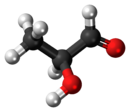Lactaldehyde
Appearance
| |||
| Names | |||
|---|---|---|---|
| IUPAC name
2-Hydroxypropanal
| |||
| Other names
Hydroxypropionaldehyde
| |||
| Identifiers | |||
3D model (JSmol)
|
|||
| ChEBI | |||
| ChemSpider | |||
| ECHA InfoCard | 100.237.284 | ||
| KEGG | |||
PubChem CID
|
|||
CompTox Dashboard (EPA)
|
|||
| |||
| |||
| Properties | |||
| C3H6O2 | |||
| Molar mass | 74.079 g·mol−1 | ||
| Related compounds | |||
Related aldehydes
|
Glycolaldehyde | ||
Except where otherwise noted, data are given for materials in their standard state (at 25 °C [77 °F], 100 kPa).
| |||
Lactaldehyde is an intermediate in the methylglyoxal metabolic pathway. Methylglyoxal is converted to D-lactaldehyde by glycerol dehydrogenase (gldA). Lactaldehyde is then oxidized to lactic acid by aldehyde dehydrogenase.[1]
Lactaldehyde exists in several forms: in open-chain form and as cyclic hemiacetal; in solution and in crystal forms; as monomer and as dimer. In crystal form, three conformers occur as hemiacetal dimers with a 1,4-dioxane ring skeleton:

In equilibrium solution, negligibly small amounts of the monomer and at least one five-membered ring dimer exist.[2]
References
- ^ Huang PC, Miller ON (1958). "The metabolism of lactaldehyde, page 205" (PDF). J. Biol. Chem. 231 (1): 201–5. PMID 13538961.
- ^ Takahashi, H (1983). "Conformational studies of DL-lactaldehyde by 1H-NMR, Raman and i.r. spectroscopy". Spectrochimica Acta Part A: Molecular Spectroscopy. 39 (6): 569–572. doi:10.1016/0584-8539(83)80108-1.


